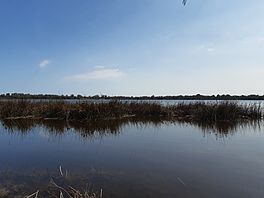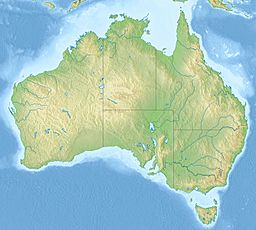Yangebup Lake facts for kids
Quick facts for kids Yangebup Lake |
|
|---|---|

Yangebup Lake seen from the southern shore in October 2020
|
|
| Location | Yangebup |
| Coordinates | 32°07′06″S 115°49′48″E / 32.11833°S 115.83000°E |
| Basin countries | Australia |
| Designation | Beeliar Regional Park |
| Surface area | 77 ha (190 acres) |
Yangebup Lake is a freshwater lake located in the suburb of Yangebup. This area is about 18 kilometers (11 miles) south-west of Perth, the capital city of Western Australia. Yangebup Lake is an important part of the Beeliar Regional Park.
Contents
What's in a Name?
The name Yangebup Lake comes from the Nyungar word yanget. This word refers to the bullrush plant (Typha domingensis), which grows in the area. European settlers first wrote down the lake's name in 1841. The suburb of Yangebup officially got its name in 1977. Interestingly, Lake Yanchep and its suburb, Yanchep, in northern Perth, have a similar name origin.
A Look Back in Time
Indigenous History and Culture
For thousands of years, the land around Yangebup Lake was home to the Wadjuk people. They are part of the larger Noongar nation. It is believed they have lived here for about 40,000 years. The wetlands of Beeliar Regional Park were very important to them. They provided food and water.
North Lake Road, which runs near the lake, follows an old track. This track was once a vital path connecting the Fremantle area to the land further east. Yangebup Lake is still very important to the local Indigenous people. It holds special meaning in their stories, history, and ceremonies. It is also a registered site of Aboriginal Cultural Significance.
European Settlement and Farming
European settlers started arriving in the 1880s. They received land grants and began using the land for farming. They raised sheep, cows, poultry, and pigs. They also grew crops. This wider area became known as the Jandakot Agricultural Area.
Over time, large-scale farming became difficult because the soil was not very good. Farmers then switched to market gardens, but these also needed a lot of fertilizer. By the early 1920s, this type of farming also declined. A short railway, called the Baldivis Tramway, was built south of the lake. It connected Jandakot railway station to the Peel Estate, a farming area further south. This tramway was taken apart in 1925.
The Wool Scouring Industry
In the 1920s, a wool cleaning business started on the eastern shore of the lake. This business, called Jandakot Wool Scouring Co., used the lake's fresh water to clean wool. It operated for 70 years. However, the waste from the cleaning process caused pollution in the lake. Harmful substances like lead, chromium, and arsenic were found in the lake's mud.
The company modernized its facilities in 1972. By the mid-1980s, people became more concerned about the pollution. In the late 1990s, the company moved its operations to East Rockingham. The old facility was then taken down.
Protecting the Lake
Water Management Efforts
As new suburbs grew around the lake, Storm water runoff became a problem. Untreated water flowed into the lake, causing its water level to rise. This damaged the plants around the lake. To fix this, the South Jandakot Drainage Scheme was started in 1995. This plan helps control the lake's water level by sending excess water to a treatment facility at Woodman Point.
Dealing with Pollution
Yangebup Lake still faces challenges from pollution. Fertilizers from farms and gardens nearby contain nitrogen and phosphorus. These chemicals flow into the lake, causing it to become very rich in nutrients. This condition is called hyper-eutrophic.
When there are too many nutrients, it causes algae blooms (a rapid growth of algae) in the lake. These blooms can make the water green and smelly. They also lead to a lot of midges breeding, which can be a nuisance.
To help with this, the City of Cockburn, the local council, built special treatment systems in 2016. These systems, located on the eastern shore, are designed to remove nutrients from the water. While they have had some success, efforts to fully restore the lake's health are ongoing.


